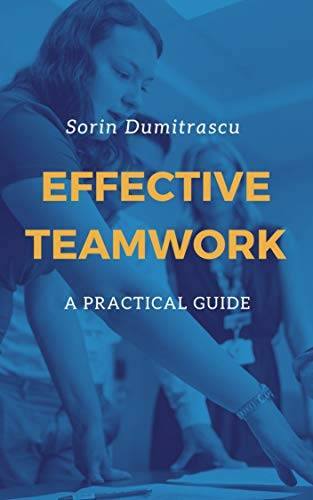

Effective Teamwork: A Practical Guide
by Sorin Dumitrascu
Technological advances, global competition, environmental and legal issues, these and other forms of workplace turbulence mean that companies have to constantly adapt. One way companies have adapted is by using teams in the workplace. In fact, leaders in business and industry increasingly point to being able to work collaboratively as a key to success in a worldwide economic environment.
In this book, you'll learn techniques to help you become even more effective and valued as you maximize your role as a team member. You'll explore ways to adopt a positive approach to being on a team as you develop and maintain a positive mind-set about your team. You'll also learn how to be proactive and how to demonstrate tolerance toward team members. And you'll understand how to work collaboratively to achieve your team's goals.
Any group of individuals will contain people with distinct personalities, specialized skills, and ideas of what they want to accomplish. So, just what makes a team, a team? The one characteristic that distinguishes a team from an ordinary group of people is that the highest priority of its members is the accomplishment of team goals.
In this book, you'll learn about establishing team goals, aligning team goals and competencies, and clarifying expectations about individual and team responsibilities.
Teams are a familiar concept. Since childhood, most people have been a member of one team or another, from sports teams to work teams. Being part of a team means working with others toward a common goal. Team cohesiveness – how bound together the team members are – determines how effective the team will be, particularly in responding to outside pressures.
In this book, you'll explore the three strands of the cord that intertwine to create a cohesive team: communication, cooperation, and trust. You'll learn to recognize some of the indicators that point to a lack of cohesion and the elements they signify are most lacking. You'll also learn to apply the strategies for building trust, improving communication, and increasing cooperation to improve overall team cohesion.
Effective communication doesn't just happen. True, some people seem to have an innate ability to always get their points across clearly. And some people seem to be naturally good at listening and getting people to open up. But for many others, perhaps yourself included, effective communication is something they have to work at. And in a team environment, it's vital that you maintain open communication – it's the only way your team can be effective.
Perhaps you've heard the proverb "See no evil, hear no evil, speak no evil." While its origin and meaning are still debated, one common, modern interpretation is that it describes the desire to avoid becoming involved in a situation. Imagine how your team would function if all its members shared this philosophy.
Most business experts would agree that if you have information and ideas that would help someone perform better, it's practically unethical not to share them. This is strong, yet appropriate, advice for teams that want to achieve optimal performance.
In this book, you'll learn techniques to help you become even more effective and valued as you maximize your role as a team member. You'll explore ways to adopt a positive approach to being on a team as you develop and maintain a positive mind-set about your team. You'll also learn how to be proactive and how to demonstrate tolerance toward team members. And you'll understand how to work collaboratively to achieve your team's goals.
Any group of individuals will contain people with distinct personalities, specialized skills, and ideas of what they want to accomplish. So, just what makes a team, a team? The one characteristic that distinguishes a team from an ordinary group of people is that the highest priority of its members is the accomplishment of team goals.
In this book, you'll learn about establishing team goals, aligning team goals and competencies, and clarifying expectations about individual and team responsibilities.
Teams are a familiar concept. Since childhood, most people have been a member of one team or another, from sports teams to work teams. Being part of a team means working with others toward a common goal. Team cohesiveness – how bound together the team members are – determines how effective the team will be, particularly in responding to outside pressures.
In this book, you'll explore the three strands of the cord that intertwine to create a cohesive team: communication, cooperation, and trust. You'll learn to recognize some of the indicators that point to a lack of cohesion and the elements they signify are most lacking. You'll also learn to apply the strategies for building trust, improving communication, and increasing cooperation to improve overall team cohesion.
Effective communication doesn't just happen. True, some people seem to have an innate ability to always get their points across clearly. And some people seem to be naturally good at listening and getting people to open up. But for many others, perhaps yourself included, effective communication is something they have to work at. And in a team environment, it's vital that you maintain open communication – it's the only way your team can be effective.
Perhaps you've heard the proverb "See no evil, hear no evil, speak no evil." While its origin and meaning are still debated, one common, modern interpretation is that it describes the desire to avoid becoming involved in a situation. Imagine how your team would function if all its members shared this philosophy.
Most business experts would agree that if you have information and ideas that would help someone perform better, it's practically unethical not to share them. This is strong, yet appropriate, advice for teams that want to achieve optimal performance.

